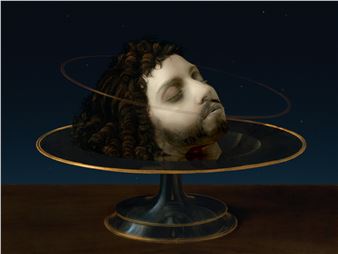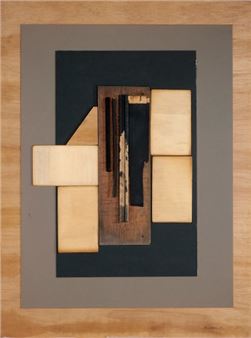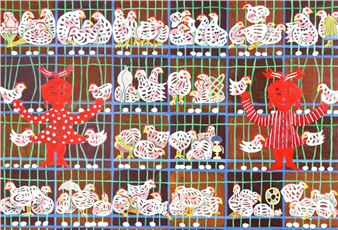Edgar Negret, Louise Nevelson, Eduardo RamГrez Villamizar: New Classicism in Collage
During the late 1950s and early 1960s, artists around the world redefined the concept of abstraction seeking to explore new possibilities in painting and sculpture. A paradigmatic manifestation of this broader shift was advanced by a transnational group of artists based in New York who shared a preference for lucid, clear design, hard-edged geometrical shapes, and a restricted color palette often limited to flat primary colors and monochromes. Although critics and curators used different labels to define and characterize this new type of abstraction—including Hard-Edge (Jules Langsner and Lawerence Alloway), Post-Painterly Abstraction (Clement Greenberg), Geometric Abstraction (John Gordon), Concrete Expressionism (Irving Sandler), or Abstract/New/Modern Classicism (Langsner, Stuart Preston, Barbara Butler)—they all interpreted the work of the younger generation of abstractionists as belonging to a “classical” tradition. In New York, Geometric Abstraction in the early sixties was thus construed in the critical discourse of the time as a “new classicism”: an art of order, balance, and repose that was diametrically opposed to the “romantic,” overheated approaches of the action painters of a previous generation.
Three international artists stand out amid this group as important figures in the redefinition of sculptural values in postwar geometric abstraction: the Russian-born American artist Louise Nevelson and the Colombians Edgar Negret and Eduardo RamГrez-Villamizar. During the Colombians time in New York, Nevelson became a mentor for them, and she helped them pave their way in the American art scene. The three artists exhibited together in several gallery shows that signaled the advent of the classical traditions in abstraction; for example in Modern Classicism launched in February 1960 at the David Herbert Gallery in New York.
More importantly, throughout the 1950s and 60s, these artists developed parallel sculptural practices based on the assemblage of metal sheets or wooden parts, and they all share a preference for a constructive language. In 1958, Nevelson started making her famous “stacked walls” sculptures using wooden boxes that she filled with discarded objects. She cut these objects in abstract geometric shapes, joined them together inside the boxes and painted the entire construction black (she would later use white and gold). Similarly, Negret's sculptures are constructed by cutting and joining geometric pieces of painted aluminum sheet together with nuts and bolts, and in some cases painted entirely in monochromatic hues with a preference for black and red. Finally, RamГrez Villamizar also developed a constructed language in his monochromatic wooden reliefs of the early 1960s in which the artist cut and pasted pieces of wood painted in white, red or black.
Significantly, these artists’ constructive approach derived from their experiments in collage. In essence, Nevelson’s stacked walls, Negret’s aluminum sculptures and RamГrez Villamizar’s reliefs were an extension of their investigations on the possibilities of collage, of cutting and pasting together various parts. Moreover, all three artists developed a parallel artistic practice in papier collГ© and collage. Negret and RamГrez Villamizar first experimented with these during their time in Paris in the early 1950s, where collage was a common practice among abstract artists who used colored papers to produce sketches of their works (paintings, reliefs and sculptures). Nevelson, on the other hand, joined in the experimental aspects of collage and assemblage in the early 1960s in New York, and moved seamlessly between the production of her sculptures and the collages. In both instances, she gives new life to the discarded object/material by cutting, placing and pasting one next to the other. Ultimately, collage became a means for all three artists to explore a constructive language for building art.
New Classicism in Collage: Negret, Nevelson, and RamГrez Villamizar brings these artists together for the first time in fifty years, highlighting their ventures into collage—an overlooked aspect of their work that reveals the hidden depths of their creative minds. The comparative approach presented in this show unveils the diverse nature of abstraction after the Second World War, as well as its transnational character, revealing the extent to which figures such as Negret, Nevelson and RamГrez Villamizar contributed to the vitality of postwar abstraction.

Recommended for you
During the late 1950s and early 1960s, artists around the world redefined the concept of abstraction seeking to explore new possibilities in painting and sculpture. A paradigmatic manifestation of this broader shift was advanced by a transnational group of artists based in New York who shared a preference for lucid, clear design, hard-edged geometrical shapes, and a restricted color palette often limited to flat primary colors and monochromes. Although critics and curators used different labels to define and characterize this new type of abstraction—including Hard-Edge (Jules Langsner and Lawerence Alloway), Post-Painterly Abstraction (Clement Greenberg), Geometric Abstraction (John Gordon), Concrete Expressionism (Irving Sandler), or Abstract/New/Modern Classicism (Langsner, Stuart Preston, Barbara Butler)—they all interpreted the work of the younger generation of abstractionists as belonging to a “classical” tradition. In New York, Geometric Abstraction in the early sixties was thus construed in the critical discourse of the time as a “new classicism”: an art of order, balance, and repose that was diametrically opposed to the “romantic,” overheated approaches of the action painters of a previous generation.
Three international artists stand out amid this group as important figures in the redefinition of sculptural values in postwar geometric abstraction: the Russian-born American artist Louise Nevelson and the Colombians Edgar Negret and Eduardo RamГrez-Villamizar. During the Colombians time in New York, Nevelson became a mentor for them, and she helped them pave their way in the American art scene. The three artists exhibited together in several gallery shows that signaled the advent of the classical traditions in abstraction; for example in Modern Classicism launched in February 1960 at the David Herbert Gallery in New York.
More importantly, throughout the 1950s and 60s, these artists developed parallel sculptural practices based on the assemblage of metal sheets or wooden parts, and they all share a preference for a constructive language. In 1958, Nevelson started making her famous “stacked walls” sculptures using wooden boxes that she filled with discarded objects. She cut these objects in abstract geometric shapes, joined them together inside the boxes and painted the entire construction black (she would later use white and gold). Similarly, Negret's sculptures are constructed by cutting and joining geometric pieces of painted aluminum sheet together with nuts and bolts, and in some cases painted entirely in monochromatic hues with a preference for black and red. Finally, RamГrez Villamizar also developed a constructed language in his monochromatic wooden reliefs of the early 1960s in which the artist cut and pasted pieces of wood painted in white, red or black.
Significantly, these artists’ constructive approach derived from their experiments in collage. In essence, Nevelson’s stacked walls, Negret’s aluminum sculptures and RamГrez Villamizar’s reliefs were an extension of their investigations on the possibilities of collage, of cutting and pasting together various parts. Moreover, all three artists developed a parallel artistic practice in papier collГ© and collage. Negret and RamГrez Villamizar first experimented with these during their time in Paris in the early 1950s, where collage was a common practice among abstract artists who used colored papers to produce sketches of their works (paintings, reliefs and sculptures). Nevelson, on the other hand, joined in the experimental aspects of collage and assemblage in the early 1960s in New York, and moved seamlessly between the production of her sculptures and the collages. In both instances, she gives new life to the discarded object/material by cutting, placing and pasting one next to the other. Ultimately, collage became a means for all three artists to explore a constructive language for building art.
New Classicism in Collage: Negret, Nevelson, and RamГrez Villamizar brings these artists together for the first time in fifty years, highlighting their ventures into collage—an overlooked aspect of their work that reveals the hidden depths of their creative minds. The comparative approach presented in this show unveils the diverse nature of abstraction after the Second World War, as well as its transnational character, revealing the extent to which figures such as Negret, Nevelson and RamГrez Villamizar contributed to the vitality of postwar abstraction.

 ARTISTS
ARTISTS
















